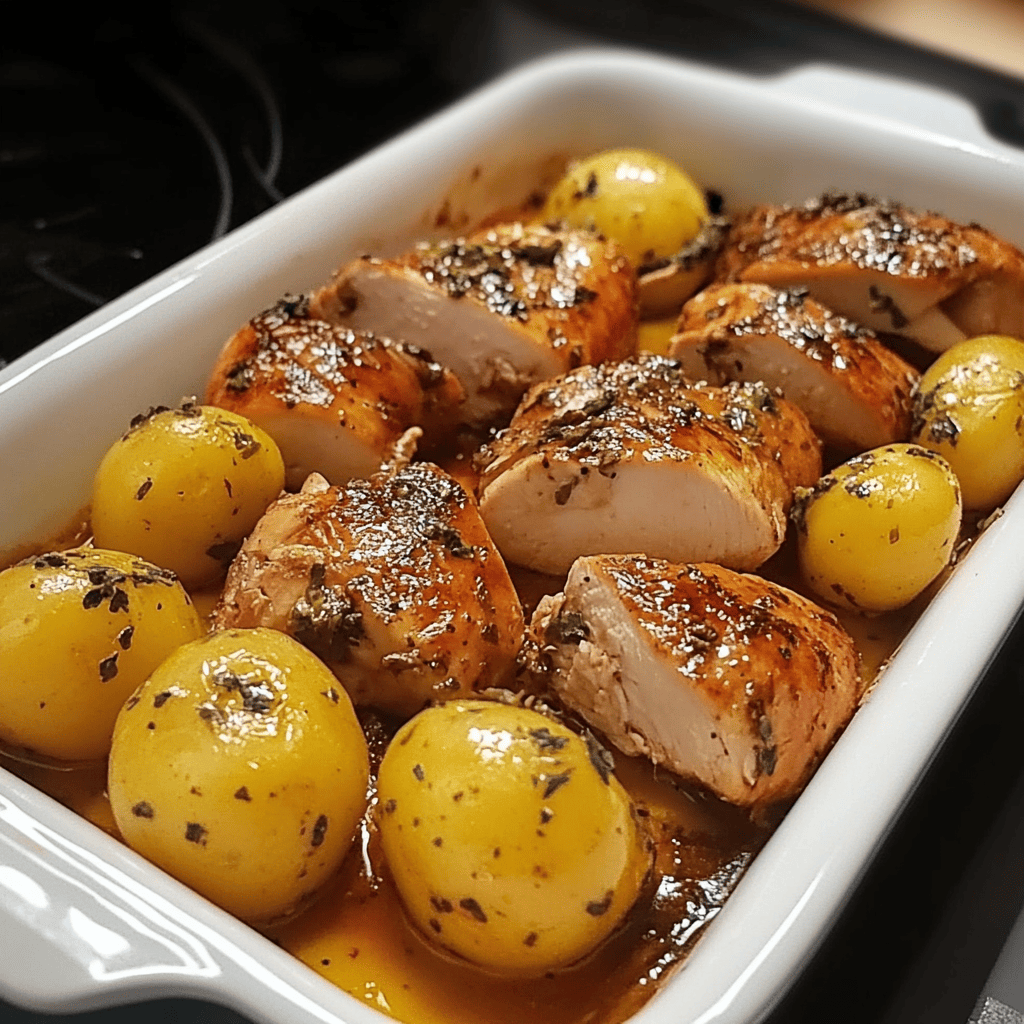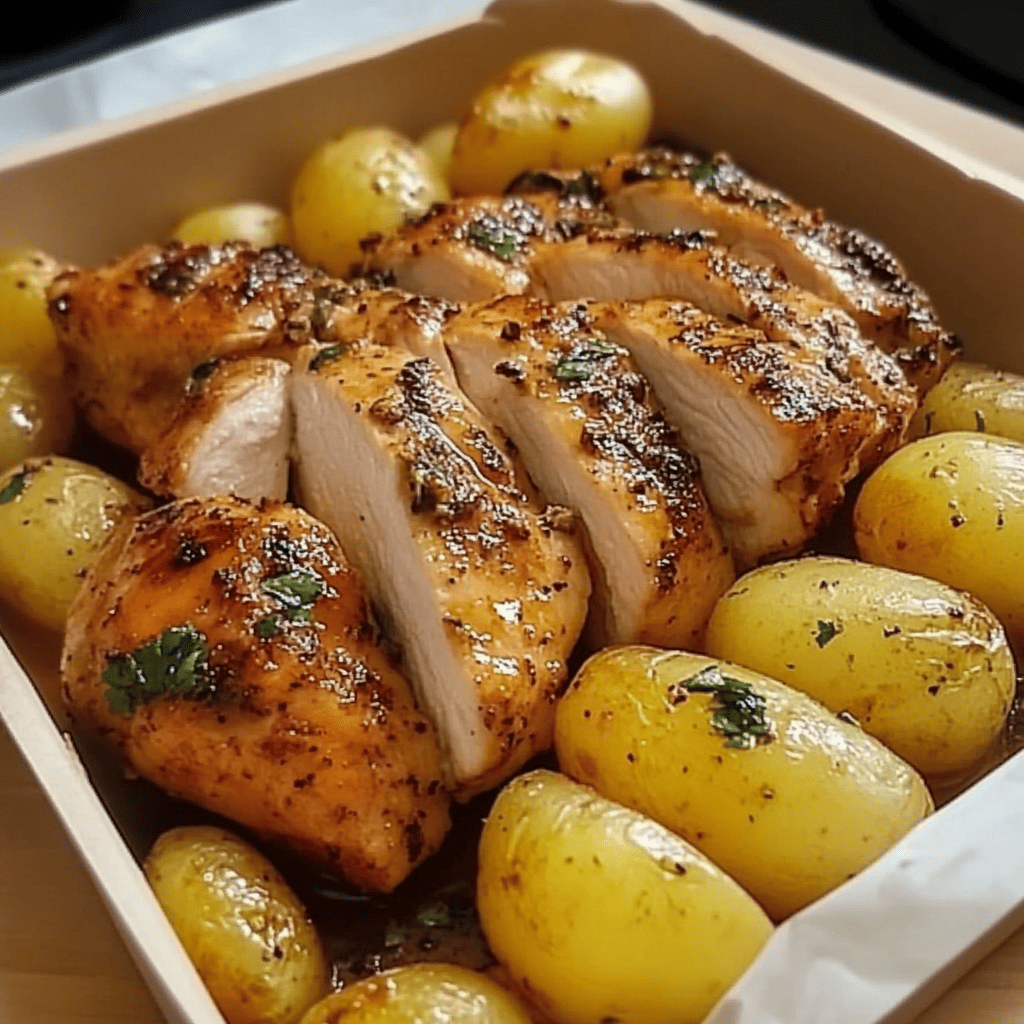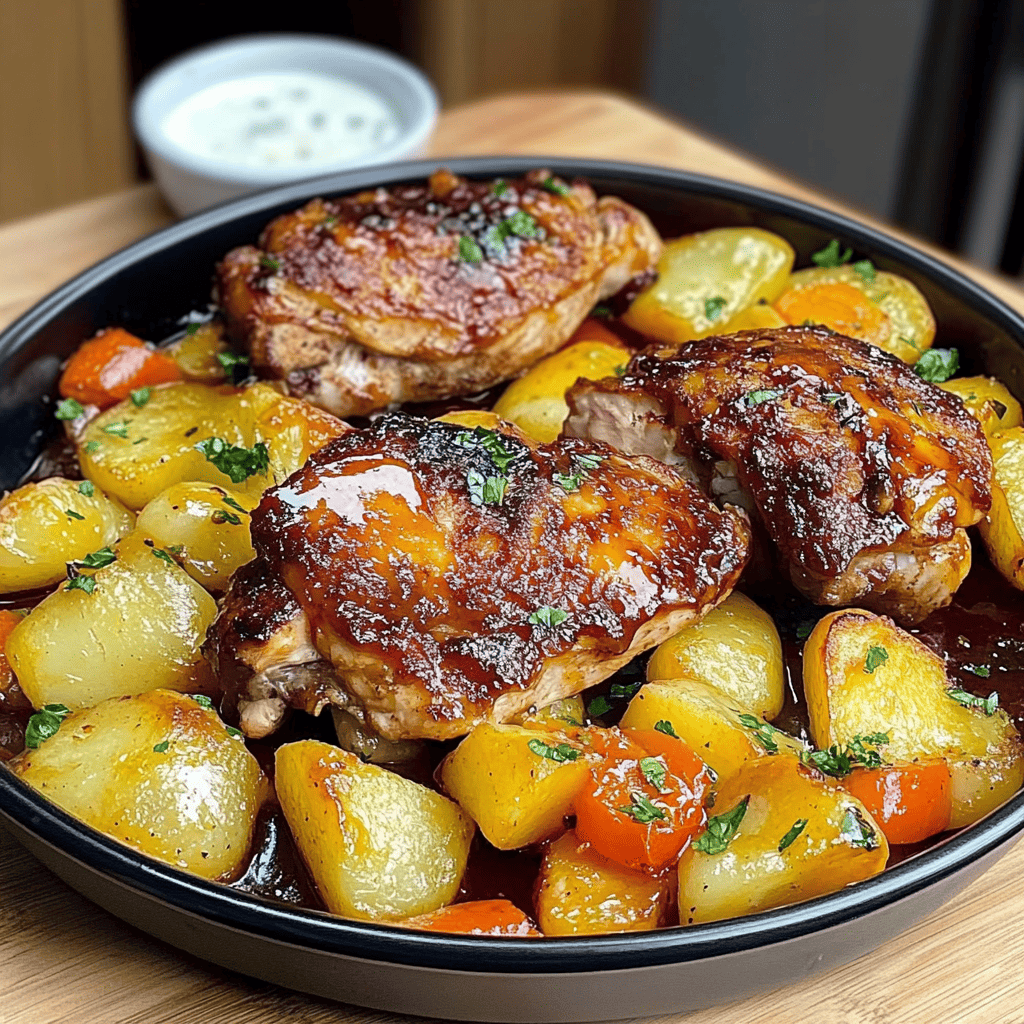Roast Chicken with Potatoes: A Golden and Comforting Classic
Introduction: Homemade Flavor and Simplicity on a Plate
“Roasted Chicken with Potatoes” is a timeless dish that has been a mainstay in countless cuisines around the world. Its appeal lies in its simplicity, versatility, and the comforting flavor it evokes. The combination of juicy, golden chicken breasts, accompanied by tender, aromatic potatoes, basted in their own juices and enhanced with fresh herbs, makes for a complete and satisfying meal. It’s perfect for a weeknight dinner, a family gathering, or whenever you’re looking for a nutritious and delicious dish without the hassle. The image shows an irresistible presentation, with the chicken sliced and ready to be enjoyed, surrounded by perfectly cooked potatoes. Discover all the secrets of this preparation that you’ll love for its simplicity and delicious results!
Detailed History in Spanish: From Ancient Stoves to the Modern Table
The history of “Roast Chicken with Potatoes” is the history of domestic cooking and the evolution of culinary techniques over the centuries. It is not a dish with a specific origin in a single culture, but rather a universal preparation that has been adapted and perfected in various culinary traditions.
The Origins of Roasting and the Domestication of Chickens: The act of roasting food over fire is one of the oldest forms of cooking, practiced since prehistoric times. The domestication of chickens dates back thousands of years in Southeast Asia, gradually spreading throughout the world. Chicken, being an accessible and versatile source of protein, became a staple in many diets.
The Potato: A Gift from the New World: The potato, native to the Andean region of South America, was introduced to Europe in the 16th century by the Spanish conquistadors. Although it initially met with resistance, its high nutritional value and adaptability to diverse climates made it an essential crop, especially beginning in the 18th century. Its versatility made it a natural accompaniment to roasted meats and stews.
The Birth of a Classic Dish: The combination of roast beef and potatoes is as logical as it is delicious. As wood-fired ovens and, later, home ovens became more common, the technique of roasting a piece of meat along with vegetables in a single pan became popular. This was not only practical, but it allowed the meat’s juices to permeate the potatoes, creating a unified and comforting flavor.
Choosing Herbs: The addition of aromatic herbs such as rosemary, thyme, and parsley is a practice that dates back to European and Mediterranean culinary traditions. These herbs, valued for both their flavor and medicinal properties, were used to enhance the taste of meats and make them more digestible. Garlic, another essential ingredient, has been a constant companion to roasted meats in many cultures.
The Popularity of Chicken: In the 20th century, with the rise of industrial farming, chicken became even more accessible and affordable, becoming a favorite choice for everyday meals. Roast chicken, in its various forms (whole, pieces, boneless), established itself as a quintessential home-cooked dish, valued for its ease of preparation and ability to feed the family.
The Boneless Chicken Version: Although whole roasted chicken is a classic, the popularity of boneless, skinless chicken breasts grew with health awareness and the search for leaner, quicker-to-cook options. Roasting chicken breasts alongside potatoes allows for faster cooking and more precise portion control, without sacrificing flavor.
In short, Roast Chicken with Potatoes is a dish that represents the evolution of home cooking throughout history, fusing basic ingredients and culinary techniques to create a complete, nutritious, and deeply satisfying meal that has stood the test of time for its flavor and simplicity.
More Historical Detail: Domestic Gastronomy and the “One-Pan Meal”
Delving a little deeper into the history and cultural significance of “Roast Chicken with Potatoes,” we can highlight:
- The Oven as a Central Tool: The proliferation of ovens in homes beginning in the 19th and 20th centuries was fundamental to the popularization of roasted dishes. Previously, roasting was more common in professional kitchens or homes with wood-burning ovens. The convenience of being able to “set and forget” a meal in the oven transformed home cooking.
- The “One-Pan Meal” Concept: Although not an ancient term, Roast Chicken with Potatoes is a precursor and perfect example of the modern “One-Pan Meal” or “Sheet Pan Dinner” concept. This current trend values the convenience of cooking a complete meal on a single pan, minimizing cleanup and simplifying the process, something our grandmothers already intuitively practiced.
- The Mediterranean Diet and Its Influences: The use of olive oil, garlic, and fresh herbs (rosemary, thyme, parsley) in this dish resonates with the principles of the Mediterranean diet, renowned for its health benefits. These ingredients not only provide flavor but also antioxidants and nutrients.
- Wildcard Dish in Various Cultures: This staple dish has equivalents in many cuisines around the world. In France, it’s ” poulet rôti avec pommes de terre” ; in Italy, “pollo al forno con patate “; in the United Kingdom, ” roast chicken with potatoes “; and in Spain and Latin America, it’s simply “pollo asado con patatas” (roast chicken with potatoes). This underscores its universality and adaptability.
- The Versatility of Potatoes: Potatoes are incredibly versatile. In this dish, baby potatoes are ideal because they roast quickly and develop tender skin and a creamy interior, absorbing the chicken’s juices exceptionally well.
This dish is a testament to how domestic cooking, over the centuries, has found ways to create nutritious, delicious, and efficient meals using simple yet powerful ingredients. It’s a reminder that sometimes the simplest dishes are the most satisfying.

Ingredients & Detailed Preparation
Ingredients:
- Chicken breasts (boneless, skinless): 2-4 pieces (approximately 600-800 g, depending on the size of the breasts and the number of diners)
- Baby potatoes (yellow and/or red), washed and cut in half or quarters if large: 700 g – 1 kg
- Extra virgin olive oil: 3-4 tablespoons
- Garlic, finely chopped: 3-4 cloves
- Fresh herbs (rosemary, thyme, or parsley), finely chopped: 2-3 tablespoons (or 1 tablespoon of dried herbs)
- Salt: To taste
- Freshly ground black pepper: To taste
- Chicken broth or vegetable broth: ½ cup (approximately 120 ml)
- Optional: Lemon juice or zest: For an extra flavor at the end
Necessary equipment:
- Baking tray (ideally ceramic or glass, as shown in the picture)
- Large mixing bowl
- Chef’s knife and cutting board
- Spoon or spatula
- Baking paper (optional, for easier cleanup)
Detailed Preparation:
- Preheat the oven: Preheat your oven to 200°C (400°F). If using parchment paper, cover the baking sheet at this point.
- Prepare the potatoes: Wash the baby potatoes thoroughly. If they’re very small, you can leave them whole. If they’re a little larger (like the ones pictured), cut them in half or quarters to ensure even cooking. Place them in a large bowl.
- Season the potatoes: Add 1-2 tablespoons of olive oil, half of the minced garlic, half of the chopped herbs, and salt and pepper to taste to the potatoes. Mix well with your hands to ensure all the potatoes are evenly coated. Spread the potatoes in a single layer on the baking sheet.
- Prepare the chicken: In the same bowl (or a new one to avoid cross-contamination), place the chicken breasts. Pat them dry thoroughly with paper towels; this helps the skin (if present, or the surface of the meat) brown.
- Season the chicken: Drizzle the chicken breasts with the remaining olive oil, the remaining minced garlic, the remaining chopped herbs, salt, and pepper. Massage the chicken to ensure the seasoning adheres well.
- Place the chicken in the tray: Make a few shallow cuts on the top of each breast (as shown in the picture); this allows the herbs and flavor to penetrate better and helps with more even cooking. Place the chicken breasts in the tray with the potatoes, leaving a little space between them.
- Add the broth: Pour the chicken (or vegetable) broth into the bottom of the pan, around the potatoes and chicken. This will help create a flavorful juice and retain moisture.
- Roast in the oven: Place the tray in the preheated oven.
- First step: Bake for 20-25 minutes. Halfway through, you can stir the potatoes lightly so they brown on all sides.
- Step 2: Turn the chicken breasts and potatoes if necessary for even browning. Continue baking for another 15–20 minutes, or until the chicken is cooked through (internal temperature of 165°F or 74°C in the thickest part) and the potatoes are tender and golden. Total cooking time for the breasts may vary depending on their thickness, but is usually between 35 and 45 minutes.
- Resting and finishing touch: Once cooked, remove the tray from the oven. Let the chicken rest for 5-10 minutes before carving; this allows the juices to redistribute and the meat to become more tender. If you like, you can drizzle with a little lemon juice or lemon zest at the end for a touch of freshness.
- Serving: Cut the chicken breasts into thick slices, as shown in the picture. Serve the chicken alongside the roasted potatoes, basting everything with the delicious cooking juices that have formed in the pan.
Estimated Preparation Time
- Active preparation (cutting, seasoning): 15-20 minutes
- Oven cooking time: 35-45 minutes
- Resting time: 5-10 minutes
- Total time: Approximately 55 minutes to 1 hour and 15 minutes
Additional Tips
- Choosing the chicken: Although the recipe calls for boneless, skinless chicken breasts, you can use skinless or boneless chicken thighs (adjusting the cooking time slightly to ensure they’re cooked through and the skin stays crispy). Whole chicken also works, but the cooking time will be much longer.
- Marinating: For an even deeper flavor, you can marinate the chicken breasts in olive oil, garlic, herbs, and lemon juice for at least 30 minutes (or up to several hours in the refrigerator) before grilling.
- Herb Variety: Experiment with other herbs such as oregano, marjoram, or even a Provençal herb mix.
- Additional Vegetables: For an even more complete dish, you can add other vegetables that roast well, such as broccoli, baby carrots, sliced bell peppers, or onion wedges, making sure they don’t overcrowd the pan.
- Different types of potatoes: If you can’t find baby potatoes, you can use large potatoes cut into 2-3 cm cubes. Make sure the pieces are similar in size for even cooking.
- For extra browning: If the chicken or potatoes aren’t browning enough, you can broil the oven for a few minutes at the end, keeping a close eye on them to make sure they don’t burn.

Frequently Asked Questions
- Can I use chicken with skin on? Yes, in fact, the skin will add more flavor and a delicious crispy texture. Make sure the skin is dry before seasoning so it browns well.
- Is chicken broth necessary? It’s not strictly necessary, but broth helps retain moisture and create more flavorful juice at the bottom of the pan, which is delicious for the potatoes and chicken. You can substitute water if you don’t have broth.
- How do I know if the chicken is cooked? The safest way is to use a meat thermometer. The internal temperature of the chicken should reach 165°F (74°C) in the thickest part of the breast. If you don’t have a thermometer, make sure the juices run clear when you pierce the meat.
- Can it be prepared in advance? You can season the chicken and potatoes in advance (up to a day in the refrigerator) and roast them just before serving. Once cooked, it’s best enjoyed fresh, although leftovers can be stored.
Texture and Flavor
The texture of this Roast Chicken with Potatoes is a delight of contrasts. The chicken breasts are incredibly juicy and tender on the inside, with a golden, slightly crispy surface on the outside, enhanced by the herbs. The potatoes, meanwhile, are soft and creamy on the inside, with slightly caramelized edges, absorbing the rich cooking juices. The layer of chopped herbs on the surface of the meat adds a grainy and aromatic texture.
The flavor is robust and comforting. The chicken has a mild flavor infused with the depth of garlic and the fragrance of herbs (rosemary and thyme). The potatoes absorb the chicken’s juices, acquiring an umami and slightly salty taste. The broth at the bottom of the pan reduces and concentrates, creating a savory sauce that unites all the components of the dish. It’s a dish with a homey, warm, and satisfying flavor that balances simplicity with the richness of well-roasted ingredients.
Consumer Context
Roast Chicken with Potatoes is ideal for various occasions:
- Family dinner: An easy and nutritious dish that everyone will like.
- Weeknight Meal: Quick to prepare and requires little cleanup, ideal for busy days.
- Meal prep: Leftovers are great for lunch the next day.
- Picnic or outdoor meals: Can be served cold or at room temperature.
- Comfort food: Perfect for a cold day or when you’re looking for something warm and nutritious.
Visual Aspect
The dish is extremely attractive and appetizing, as seen in the image. The thickly sliced chicken breasts reveal a juicy, white interior, contrasting with the golden, slightly crispy skin. The layer of chopped, dark herbs on top of the chicken adds a rustic and aromatic touch. The vibrant yellow baby potatoes appear tender and are partially submerged in a glistening golden broth, suggesting a rich and juicy flavor. The white ceramic tray further highlights the warm colors of the chicken and potatoes, making the dish look fresh, homemade, and ready to be enjoyed.
Curiosities
- The Maillard Reaction: The golden color and caramelized flavor of roasted chicken and potatoes are the result of the Maillard reaction, a series of chemical reactions that occur between amino acids and sugars when foods are heated, creating compounds that give rise to complex flavors and aromas.
- The importance of resting: Letting your chicken rest after roasting is crucial. It allows the juices that have concentrated in the center of the meat to redistribute throughout the breast, resulting in more tender and juicy meat.
- Versatility of chicken breasts: Chicken breasts are one of the most versatile parts of the chicken, ideal for roasting, baking, grilling, sautéing, or using in stews.
Nutritional Value (Estimated per Serving)
Please note that these values are approximate and may vary significantly depending on the serving size, type of chicken (skinless or with skin), and the exact amount of oil. For a serving of chicken breast (approx. 150g) and 200g of potatoes:
- Calories: 450-650 kcal
- Protein: 40-50 g (mainly from chicken)
- Fat: 15-25 g (from chicken and olive oil)
- Saturated fat: 3-6 g
- Unsaturated fats: 10-20 g
- Carbohydrates: 30-45 g (mainly from potatoes)
- Sugars: 2-5 g (natural from potatoes)
- Fiber: 4-6 g (from potatoes and herbs)
- Sodium: Variable (from added salt and broth)
- Vitamins and minerals: Potassium (from potatoes), Vitamin B6 and Niacin (from chicken), Vitamin C (from potatoes and garlic), Iron.
Additional Benefits and Interesting Facts
- Lean protein: Chicken is an excellent source of lean protein, which is essential for muscle development and satiety.
- Sustainable Energy: Potatoes provide complex carbohydrates that release energy gradually.
- Essential nutrients: A dish that provides a good variety of vitamins and minerals important for the body.
- Easy to adapt: It can be easily adjusted for low-carb diets (by reducing potatoes) or by adding more vegetables.
Other Information
- Storage: Leftover roast chicken and potatoes can be stored in an airtight container in the refrigerator for up to 3-4 days.
- Reheating: Reheat in the microwave or oven at low temperature until hot. The chicken may dry out a bit when reheating, so consider adding a little more broth.
- Pairing: Pairs well with a fresh green salad or a light white wine, such as a Sauvignon Blanc or Pinot Grigio.

Conclusion: Perfection in the Simplicity of Roasting
“Roasted Chicken with Potatoes” is a dish that encapsulates the essence of home cooking: simple ingredients transformed into a delicious and comforting meal with minimal effort. It’s a testament to how quality ingredients and proper cooking techniques can create spectacular results. Whether for a family dinner, a quick weeknight meal, or just to enjoy a taste of homestyle cooking, this dish is a winning choice that will satisfy everyone. Go ahead and try it and enjoy the magic of this timeless classic!

